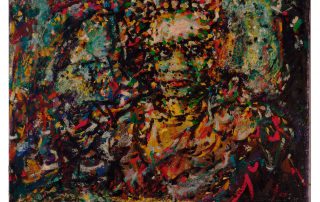Elizabeth Berkowitz2024-03-05T08:12:14-05:00November 18th, 2020|Exhibitions|
This digital exhibition includes important examples from the oeuvre of the German Jewish Expressionist artist Fritz Ascher (1893-1970). Ascher’s career extended from prior to the First World War until the late 1960s. However, Ascher’s artistic trajectory was interrupted due to persecution under National Socialism, and he spent much of the Second World War in hiding, concealed in a family friend’s basement. Ascher’s work consequently encompasses both the vibrant artistic scene in early-20th-century Germany, as well as the trauma and aesthetic shifts consequent of Ascher’s persecution and deprivations during the twelve years of the Nazi regime. These selected works are representative not only of critical moments in Ascher’s personal and artistic development, but also of key themes that occupied Ascher’s [...]
Rachel Stern2018-12-04T11:57:56-05:00December 27th, 2017|Select Press Coverage|
Fritz-Ascher-Retrospektive „Leben ist Glühn“ Die Wiederentdeckung des Expressionisten Fritz Ascher: eine Doppelausstellung in der Villa Oppenheim und im Potsdam Museum. by Elke Linda Buchholz Einen so vollständig vergessenen Künstler zurückzuholen in die Aufmerksamkeit, braucht Kraft, Geduld und kreative Energie. Vor 30 Jahren stieß die deutsch-amerikanische Kuratorin Rachel Stern bei einem Sammler auf Arbeiten von Fritz Ascher. Sie hatte noch nie von ihm gehört. Jetzt ist sie als quasi weltweit einzige Expertin für den 1893 geborenen Maler wieder zurück in der Stadt, wo auch er einst gelebt und gearbeitet hat. Hier bei Max Liebermann holte der junge Wilde sich als 16-Jähriger nach abgebrochener Schule die höheren Weihen einer Empfehlung an die Königsberger Kunstakademie und startete zwischen Secessionisten und Expressionisten seine Karriere. [...]
Rachel Stern2018-12-04T12:14:23-05:00December 22nd, 2017|Newsletter|
Dear Friends, I am humbled and honored to have received the Lea and Hans Grundig Prize for my work about Fritz Ascher. Right on time for his 125th birthday, the Fritz Ascher retrospective is now open in Berlin and Potsdam, the two places where the artist lived and worked. Museum Charlottenburg-Wilmersdorf in der Villa Oppenheim in Berlin exhibits an overview of the artist’s creative development, with a focus on works that relate to Berlin. We see his sketch of the artist Max Liebermann as well as his love for music and performance in Weimar Republic paintings like “Beethoven” and “Bajazzo and Artists”. After surviving the Nazi terror regime in hiding in the Berlin Grunewald neighborhood, he painted these works over [...]
Rachel Stern2018-12-04T12:33:00-05:00September 1st, 2017|Newsletter|
Dear Friends, It was fun to attend the opening of “Hauptstadtfussball” at the Ephraim Palais in Berlin, celebrating the 125th anniversary of the Berlin soccer club Herta BSC and its local rivals. I learned so many things about soccer in Berlin, and about Herta BSC in this creative, well researched exhibition. And you can see Fritz Ascher’s “Soccer Players” from c. 1916! It will be on view until January 8, 2018. link Thank you to Sven Goldmann for bringing Fritz Ascher alive in his full page piece in the German newspaper Der Tagesspiegel! link Here in New York, the preparations for “‘Beauteous Strivings.’ Fritz Ascher - Works on Paper” at the New York Studio School are in full swing. The New [...]
Rachel Stern2018-12-04T12:33:53-05:00July 10th, 2017|Newsletter|
Dear Friends, Time for the outdoors! What could be timelier than an exhibition about soccer. On July 26th, the Ephraim Palais in Berlin is opening “Hauptstadtfussball,” celebrating the 125th anniversary of the Berlin soccer club Herta BSC and its local rivals. In this exhibition, you can find Fritz Ascher’s “Soccer Players” from c. 1916! It will be on view until January 8, 2018: link Since the last newsletter, Wiebke Hölzer published two essays about Fritz Ascher, one in the Biographisch-Bibliografisches Kirchenlexikon (BBKL, vol. 38, Nordhausen 2017), and one called "Kunststück" examining his “Bajazzo” from 1924 in Weltkunst No. 129 from May 2017 (pp. 120-121). And our most accomplished lawyer, the author Nicholas O'Donnell, a veteran attorney and litigation partner at the [...]
Newsletter #6, May 2016
Rachel Stern2018-12-04T12:44:40-05:00May 19th, 2016|Newsletter|
Dear Friends, As we are drawn to spend more time outside in the lovely spring weather, this newsletter is all about Fritz Ascher’s late landscapes that became the focus of his work after 1945. Trees, late 1950s ©Bianca Stock, Munich Frank Auerbach, Mornington Crescent Looking South, 1997 ©Frank Auerbach, courtesy Marlborough Fine Art In dozens and dozens of intense paintings and gouaches intoxicated with color, Ascher turns to nature painting in the broadest sense. Among them are landscapes, woodland scenes, portraits of individual trees, groups of trees, all inspired by hours of walking in the nearby Grunewald. In his catalogue essay accompanying the upcoming Fritz Ascher retrospective, Eckhart Gillen relates the aesthetic practice and behavior of the two painters Fritz [...]
Newsletter #4 December 2015
Rachel Stern2018-12-04T12:45:51-05:00December 17th, 2015|Newsletter|
Dear Friends, As the days are getting shorter and darker, and will at some point probably get colder as well, I remember fondly this past summer, when I had the chance to discover the vastness and diversity of the Grunewald, the largest city forest in Berlin, with Dr. Gudrun Rademacher, the long term director of the Forest Museum Grunewald. Within minutes Fritz Ascher was there, and he often walked for hours, usually in the early mornings or late at night. He documents in his art what he sees: heavy-trunked trees stand in open landscape, shaken by the wind, deep in leaf, or winterly bare. Dr. Rademacher discovered gouaches of the Forest Museum, the Hunting Castle with its signature orange roof, [...]









